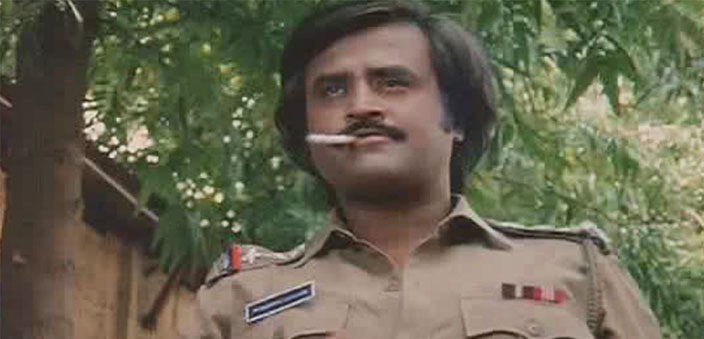Rajnikant is revered like a God figure by millions of his fans spread across the world. His most famous stunt is contained in his cigarette scenes. It has become a famous style statement tried by hundreds of young men who may have been able to copy him, but could not reach anywhere near his style. Among several tricks with the cigarette, the most famous is the one in which he flips the cigarette right into the air and it comes right back between his lips. No one thinks about the evil effects of smoking when they are watching a Rajnikant film, including his latest blockbuster Kabali. Late actress Nadira’s tantalising style of holding the cigarette at the end of a cigarette holder, and taking a puff from time to time in Raj Kapoor’s Shri 420 (1955), set the trend for female stars smoking on screen, probably borrowed from the celebrated style statement established by Marlene Dietrich, many years ago, in several Hollywood films.
Cinema’s smoking tradition
Indian cinema has been glamourising the portrayal of tobacco use through its icons since the 1950s. Ashok Kumar, Dev Anand, Raj Kapoor and Pran were often shown smoking cigarettes and cigars in films. Over the years, smoking within films has spilled over to smoking by young men and women in real life. The linkages they seem to have made with mainstream films are that of style, romance, tragedy and rebellion, too tempting for youngsters to resist imitating, either in order to seek closer identification with their favourite stars, or, to gain peer acceptance, or both. How much has Indian cinema contributed to the portrayal of smoking in films, both in qualitative and quantitative terms? What is the extent and quality of its impact on the youth? How has it affected smoking in general, and smoking among the youth in particular? These questions have been recently addressed by an interesting study that also sheds considerable light by offering quite a few significant answers to the questions raised.
Bollywood – Victim or Ally, is a study on the portrayal of tobacco in Indian cinema undertaken by the World Health Organisation’s (WHO) Strategic Mediaworks for the Tobacco Free Initiative in 2003. The aim of the study is to encourage the production of “Tobacco-Free Films”, calling upon film and fashion industries to stop promoting tobacco, which kills one in two regular users. WHO is supported by the American Medical Association, the Los Angeles Department of Health and the ‘Smoke Free Movies’ project at the University of California in its call to the film industries to rid films of their tobacco-promoting role.
The report is the outcome of increasing evidence of tobacco companies turning to the film and entertainment industry to market their deadly product. One example of this is the bravery award given to Preity Zinta, a noted actress, by Red and White, a big tobacco company owned by Phillip Morris. As a clever marketing strategy, disguised as a boost to the entertainment industry, tobacco companies have also been sponsoring ticketed shows like the Annual Filmfare awards telecast live to reach 32 million people.
The summary reveals that tobacco portrayal is common in 76% of the films that fell under the period under review, namely, 1991 to 2002. Indian mainstream cinema is the largest producer of films in the world, accounting for more than 900 films released every year in more than eight languages. Indian films target an estimated 250 million youngsters in India alone. In addition to this are the millions of Diaspora Indians in South Asia, the Middle-East, parts of the UK, USA, Africa and Europe. There are more than ten film channels that telecast films round the clock, in addition to the 12,900 cinema halls, where 188 million viewers a year buy around 5,000 million tickets.
Goswami and Kashyap discovered that instances of showing smoking/tobacco use in movies had increased significantly to 89% of all movies released in 2004 and 2005. The brand placement has also increased by nearly three folds. Tobacco brands now appear in 46% of movies having tobacco scenes. Cigarette companies have almost all the tobacco product placements, with two companies accounting for over 90% of the brand visibility. Association of tobacco with glamour and style has also been established. Amost 75% of movies having tobacco also showed the main/lead character consuming tobacco.
Checks and balances?
The Indian government banned all forms of direct and indirect forms of advertising, promotion and sponsorship, through a legislation called “Cigarette and other tobacco products Act 2003”. Despite that, many surrogate forms of advertisement continue till date. The WHO Framework Convention on Tobacco Control (FCTC) also warns about such nefarious designs in its preamble itself and recognises the “need to be alert to any efforts by the tobacco industry to undermine or subvert tobacco control efforts”, and “the activities of the tobacco industry that have a negative impact on tobacco control efforts.” The increased use of tobacco in Indian films backed by the soaring level of tobacco brand visibility in recent films state that after the ban in India on tobacco advertisements, tobacco companies began using motion pictures as a vehicle of clandestine promotion and advertisement of tobacco products in both generic and branded forms.
The findings of various global surveys on tobacco use and determinants led Indian Health Secretary Naresh Dayal to admit: “The control of tobacco consumption has become a major public health challenge in India due to the burden of non-communicable diseases. The overall tobacco consumption has increased over the past five years despite strong government initiatives in adopting the FCTC and enactment of the Anti-Tobacco Law, 2003. Ignorance among medical and dental students, too, is a matter of concern.” With present smoking patterns, about 500 million tobacco users will eventually die. More than half of these will be today’s child and teenaged smokers. This is where, the campaigners feel, our film stars can help.
The then Union Health Minister Anbumani Ramadoss appealed to Amitabh Bachchan and Shah Rukh Khan to give up smoking on screen. The minister, in his efforts to check tobacco imagery in films, had earlier brought a law to regulate such scenes. This move was challenged in the court by filmmaker Mahesh Bhatt, with support from the Film Certification Board chairperson Sharmila Tagore. Tagore shared Bhatt’s view alongwith other film personalities (including Aamir Khan and John Abraham) that such a regulation would amount to putting curbs on creative freedom and artistic expression. In 2005, the rules were further refined to combat smoking in films, since it was felt that surrogate advertising through films had gone up since the 2003 ban. It included measures that have been pushed now – no character to be shown smoking, older movies to have health warnings, etc. Bhatt filed a petition challenging the last notified Act banning smoking in films. On the basis of that petition, the Delhi High Court in 2009 struck down the ban on smoking in films.
The final policy?
The situation has changed since August 1 this year. According to a news report in The Indian Express (August 1, 2016), in a relief to film producers, the Shyam Benegal expert committee on film certification has recommended doing away with the current system of carrying disclaimers during each smoking scene and has instead suggested that there should be just one anti-smoking static warning at the start of the film. The suggestion by the eight-member panel is based on the need for “smooth viewing of films” which, it has said, is currently disturbed by showing the static warnings in every smoking scene.

An interesting real-life anecdote is related to the film No Smoking directed by Anurag Kashyap. Released in 2007, the film focussed on a surrealistic story that shows how a man joins a course to kick his addiction. He finds the course a bizarre, horrific journey. Sadly, the film did not do well commercially and flopped miserably at the box office. The film also had two major song numbers called Phoonk De and Jab Bhi Cigarette, the title track. Both songs were rendered by Rekha Bharadwaj who had also belted out the Beedi Jalaile number in Vishal Bharadwaj’s Omkara. This points out to the use of ‘smoking’ in lyrics, songs and song picturisations in Indian films. The interesting behind-the-scenes story is that the film’s hero John Abraham does not smoke in real life. But to make the character convincing on screen, he smoked up to 90 cigarettes a day during the shooting to give the film a more believable look. Later, when the film was complete, Abraham went for an X-ray and found his lungs were heavily damaged. Though No Smoking went to several festivals in India and abroad, on hindsight, the film seems to have done more harm than good through its so-called campaign against smoking for its audience. Interestingly, the two early contenders for the role later played by John Abraham were Shah Rukh Khan and Saif Ali Khan respectively, both known to be heavy smokers in real life. But they declined the film.


